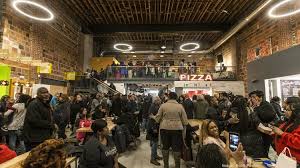MANDI Awards Feature: Sherman Phoenix, State Farm Building Blocks Award
Rising from the ashes of a building damaged by a former BMO Harris Bank building damaged by a fire in Milwaukee’s Sherman Park neighborhood just over one year ago, Sherman Phoenix offers a space to support small businesses and unite the community.
“The mission of the Sherman Phoenix is really to serve as a cultural hub for art, entrepreneurs ... and culturally being able to be a place that nurtures the desires of our community all who live, work and serve in Milwaukee,” JoAnne Sabir, co-owner of the Sherman Phoenix, said.
The Sherman Phoenix is guided by three main objectives: to transform vacant property, support entrepreneurship and build community wealth.
Sabir said that transforming the dilapidated BMO Harris building was a challenge.
“It was upside down. So we needed to be creative,” she said. “What was needed to redevelop the building was more than what a bank would appraise it at.”
Despite the challenge, the space rose up, hoping to bolster Sherman Park as a result.
“I think the story is significant: the repurposing, the possibility of channeling something that was a really horrific, challenging time in our city and being able to repurpose it really speaks to what's possible in the face of challenge,” Sabir said. “Sherman Park was — and is — mired by significant hardship but has lots of assets.”
Sabir and her co-developer, Juli Kaufmann, recognized the talent and potential within the Sherman Park neighborhood and strove to give owners a space in which their businesses could thrive.
According to the Sherman Phoenix website, “By providing mentorship and coaching, the project supports entrepreneurs of color to help them grow their businesses, generate jobs, and support the local economy.”
There are currently 29 entrepreneurs working in the Sherman Phoenix building, offering services related to food, wellness, arts and culture.
“We've really had the opportunity to invest not just in the provision of a physical space but the other needs that our tenants have shared over time through our personal mentorship,” Sabir said.
To build community wealth, “The project engages neighbor investors, supports small businesses, and demonstrates that socially just and culturally rich real estate projects can be successful in disinvested communities,” according to the website.
Building that wealth comes from within the Sherman Phoenix’s walls and flows outward. Sabir said the goal is to invest in their own tenants and in the wider area by engaging other entrepreneurs and businesses who aren’t necessarily tenants in other capacities surrounding the project.
“We were estimating that we've created about 150 jobs,” she said. “And then there are other things that come into play. … We view the Phoenix as a catalytic opportunity, meaning if we find value or show the value of being a community then it really does — it has — sparked other developments and other programmatic undertakings within the Sherman Park neighborhood.”
Supporting the vitality of a community not only involves the economy. The Sherman Phoenix operates to generate income for entrepreneurs and neighboring businesses, but it also seeks to connect Milwaukee residents.
“We have this thought around, ‘What can’t you get on Amazon?’ And what we found was that people really do want to convene, they want to be a part of a community,” Sabir said. “The malls are dying, but you still want to get your makeup done, you still want to get your hair done.”
Sabir pointed to what is missing from the virtual world of commerce and what a community space like the Sherman Phoenix can bring to residents.
“It's all of the love,” Sabir said. “It's very tangible when there's a financial win for any of our entrepreneurs, but it's the love. … It's a consistent message from all our neighbors that when you come into the Phoenix, you'll see a cross section of not just our city but our state, so there's so much resounding love. It’s palpable. You can feel it when you come into the Phoenix.”
Sabir said that it is even difficult for her to hold meetings in the building because of how connected everyone is.
“It’s become a daily family reunion, she said. “There's always somebody that wants to talk or give a hug.”
Apart from the immediate economic and community impacts the Sherman Phoenix has, Sabir said she hopes the project to serve a broader purpose.
“I have to reflect on how significant this development is. It's beyond bricks and mortar,” Sabir said. “My hope is that being seen as an African American woman in the community, I hope it provides a point of inspiration for more of this. More of ... folks really digging back into the community and reimagining our spaces and claiming our spaces and owning our spaces. ... It gives me a wider platform to do more good.”